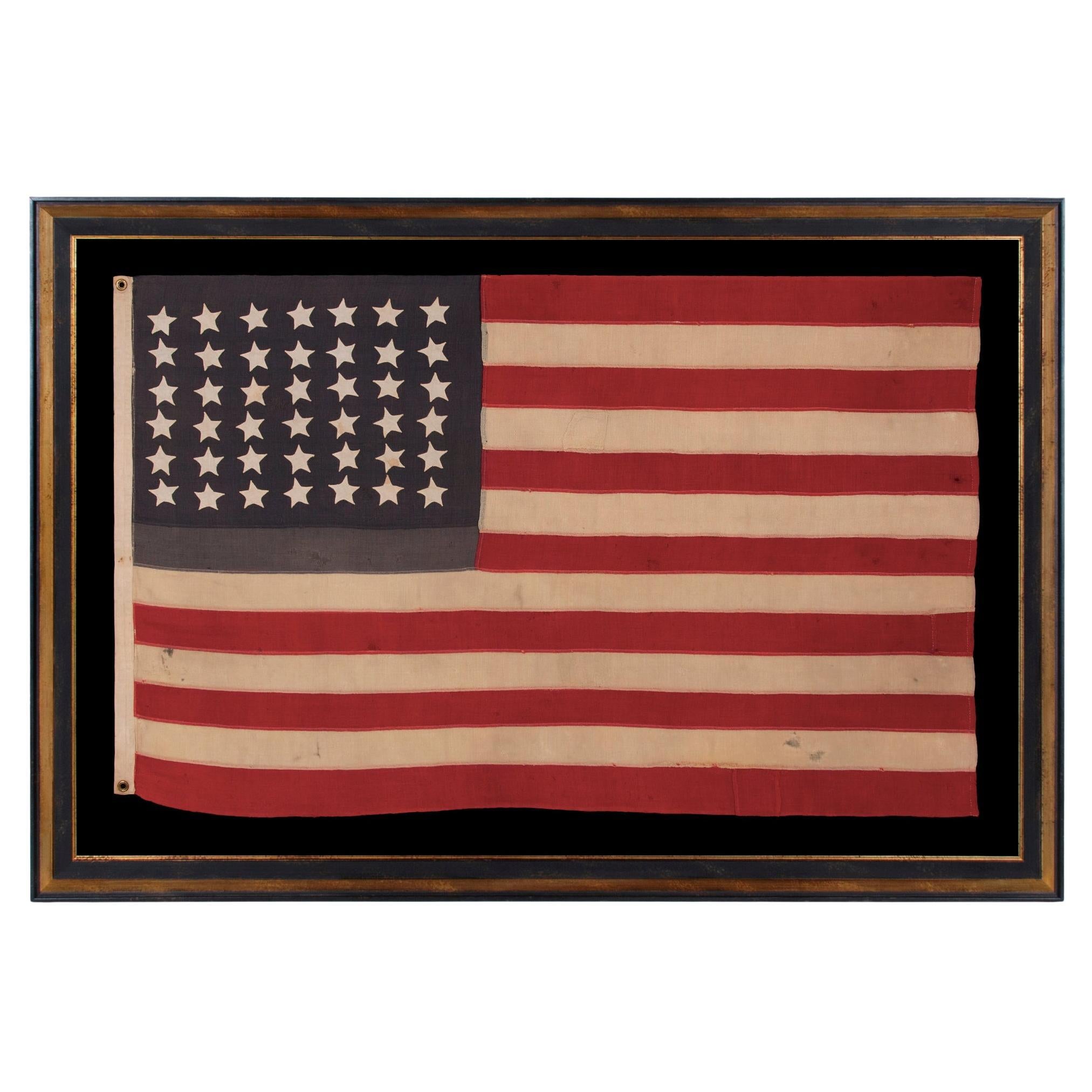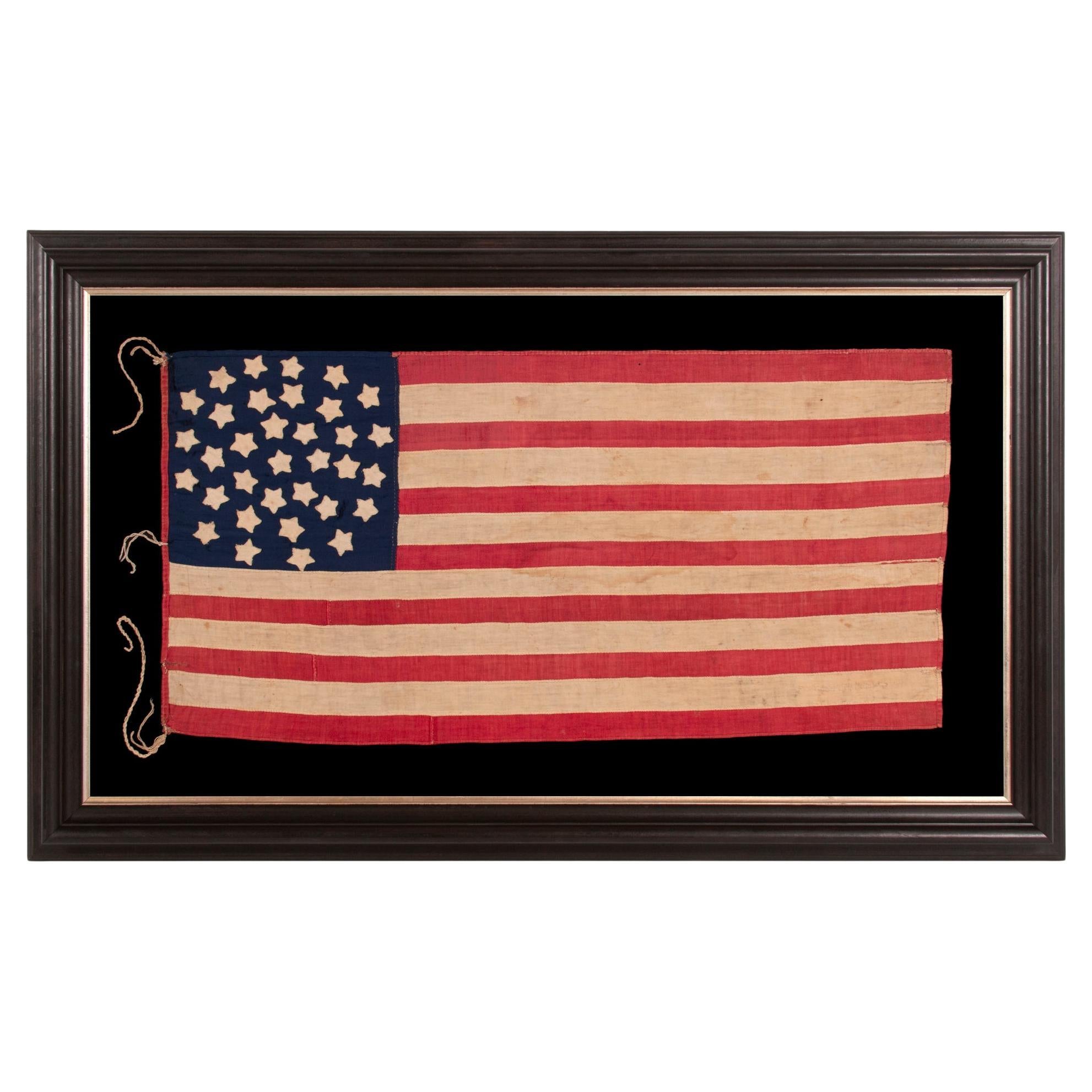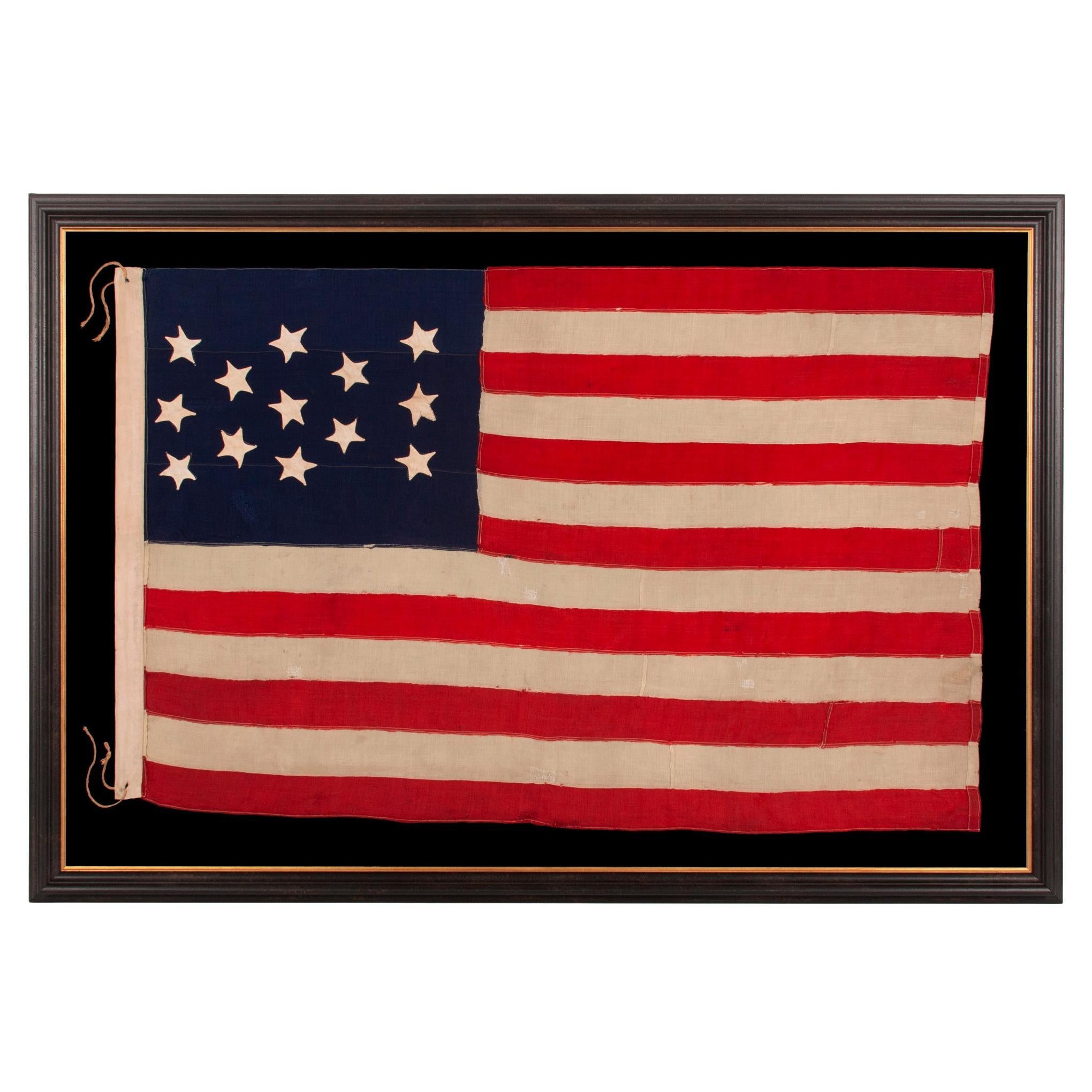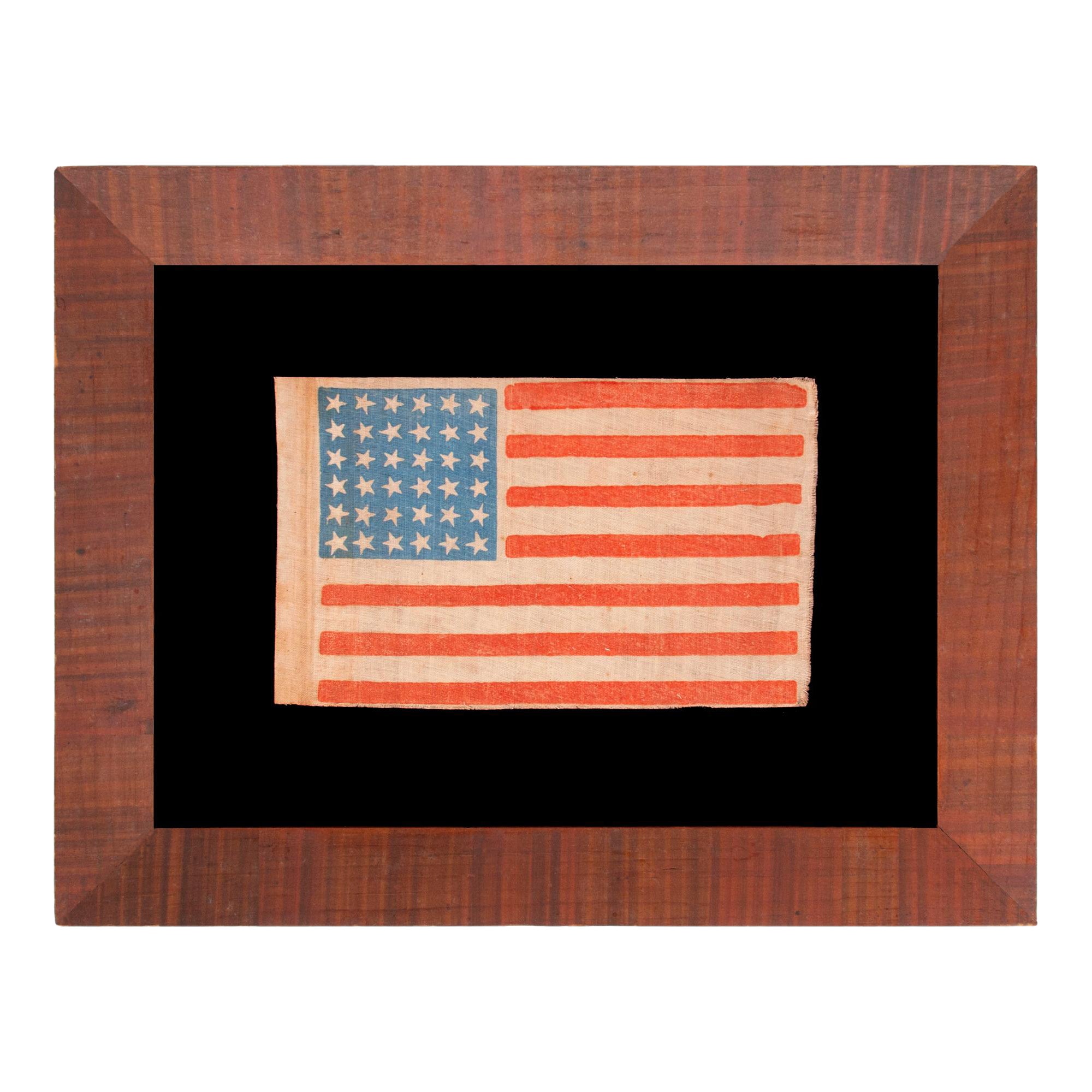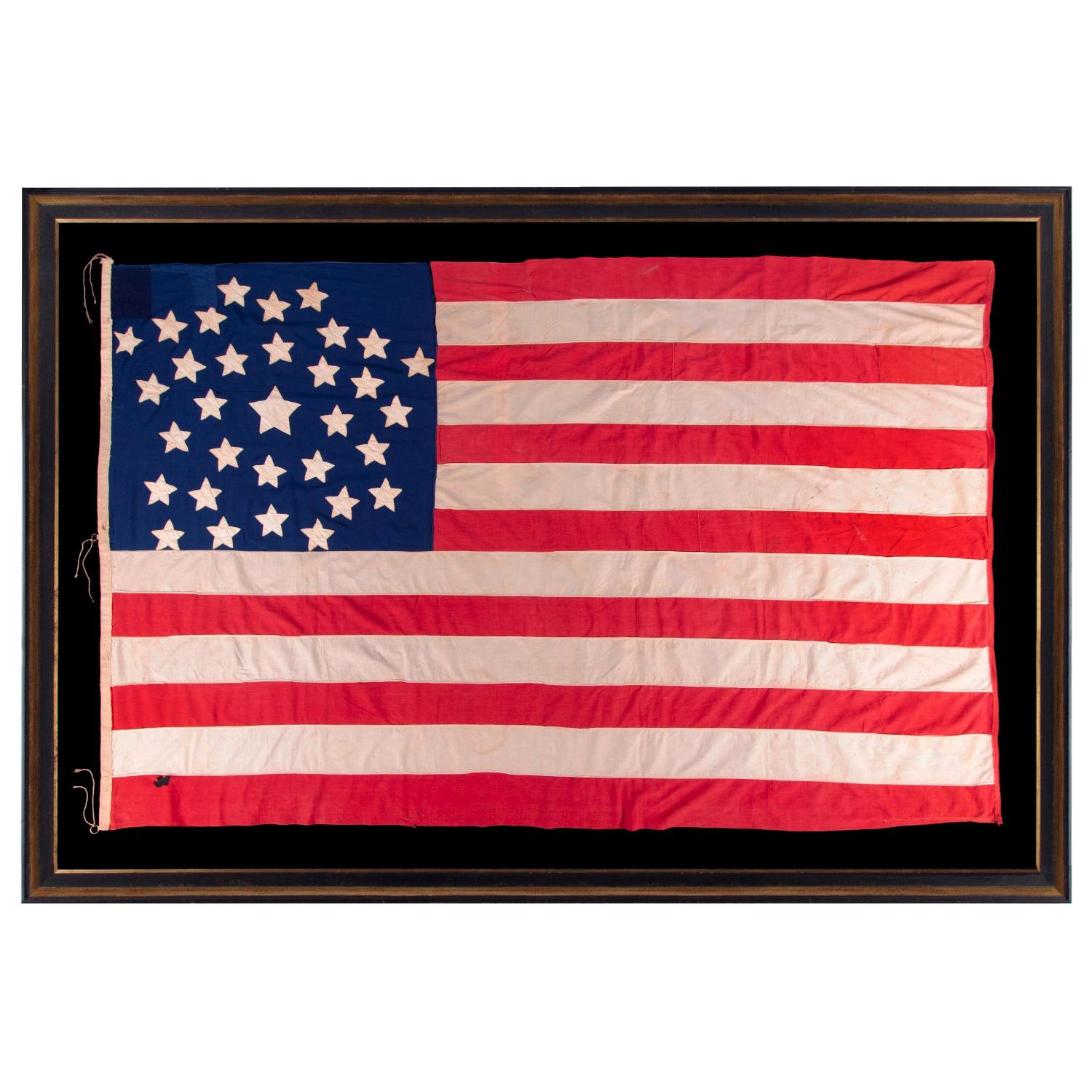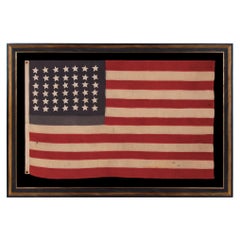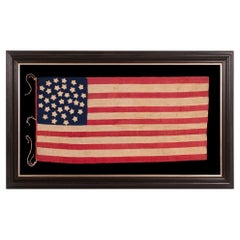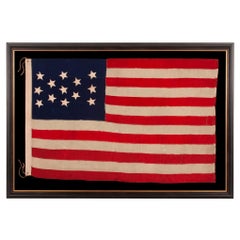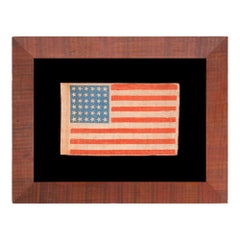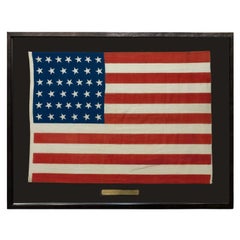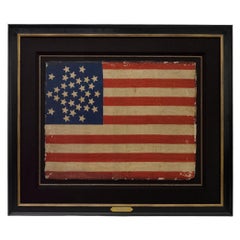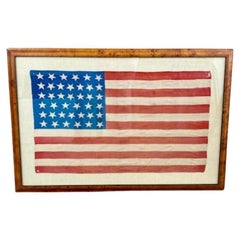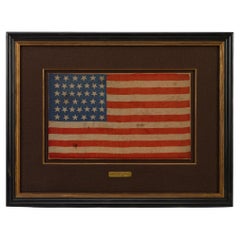Items Similar to 34 TUMBLING STARS on an ANTIQUE AMERICAN FLAG, CIVIL WAR PERIOD, 1861-63, KANSAS
Want more images or videos?
Request additional images or videos from the seller
1 of 8
34 TUMBLING STARS on an ANTIQUE AMERICAN FLAG, CIVIL WAR PERIOD, 1861-63, KANSAS
Price Upon Request
Price Upon Request
Price Upon Request
Price Upon Request
Price Upon Request
Price Upon Request
Price Upon Request
Price Upon Request
Price Upon Request
Price Upon Request
About the Item
34 STARS WITH "DANCING" OR "TUMBLING" ORIENTATION, ON AN ANTIQUE AMERICAN FLAG WITH EXTRAORDINARY COLORS, PRESS-DYED ON WOOL BUNTING, LIKELY PRODUCED FOR USE AS MILITARY CAMP COLORS, CIVIL WAR PERIOD, 1861-1863, REFLECTS THE ADDITION OF KANSAS TO THE UNION AS A FREE STATE:
34 star American national flag, press-dyed on wool bunting, with beautiful colors and interesting visual features. Note how the stars, which are arranged in linear rows of 7-7-6-7-7, are oriented consecutively point-up, point down in their vertical alignment across the canton, resulting in what I call “tumbling” or “dancing” formation. Also note how the shade of cornflower blue exhibits interesting, periwinkle blue overtones, and how it contrasts with the deep, scarlet red. There is a hand-sewn, cotton binding along the hoist.
I believe that this extremely scarce style of 34 star flag, in this design, was sometimes sold to the Union Army, to be flown as flank markers or camp colors. Examples are known in both wool and silk, in the same style, with similar coloration. I owned an example of the same exact type, in silk, with overprinted text for a Pennsylvania volunteer regiment. Silk was light weight, and was the traditional fabric for land-use, military flags in the north. flags hand-carried by infantry and cavalry regiments in the North. Wool sheds water and was practical for long-term use in inclement weather.
It is likely that flags in this style, in both wool and silk, were simultaneously sold for whatever purpose the buyer wished. Some probably saw short-term use at parades and political events, as well as in service as props in commercial photography, for portraits of Civil War soldiers. Whatever the case may be, the size is excellent, being small enough to be easily framed and displayed, yet large enough to make a substantial impact, great for both serious collectors and one-time buyers alike.
Kansas was admitted into the Union as the 34th state on January 29th, 1861, about 2 ½ months before the Confederate assault on Fort Sumter that marked the beginning of the Civil War. The 34th star was officially added on July 4th of that year, but most flag makers would have added a 34th star at the time of Kansas’ arrival, if not even before that day—a practice that became common during the latter 19th century. This star count remained official until July 4th, 1863, and 34 star flags would have generally been produced until the addition of West Virginia in June of that year, 11 days before the Battle of Gettysburg.
Some Notes on the Press-Dying Process:
First patented in 1849, the press-dying process was thought to be a novel idea that would improve flag-making efficiency. In this case, for example, it could potentially alleviate the chore of hand-appliquéing 68 stars (34 on each side). In reality, however, the result must have been less efficient than sewing. To achieve white stars, for example, metal plates in the shape of stars had to be clamped to either side of a length of woolen fabric, in the desired configuration, so they were back-to-back. These may have been lightly brushed beforehand with a solution that would resist dye, or perhaps with a thin coat of wax. The stars were clamped together tightly, the bunting was dyed blue, and the areas where the metal stars were positioned would be left white. For flags with press-dyed stripes, the same task was repeated with different clamps.
A form of resist-dyeing, this method often resulted in crude characteristics, such as stripes with irregular lines, in various widths, and stars with inconsistent shapes, in slightly varying sizes. It is likely that this resulted in some lost product and wasted time, from flags that had bleeding or misprint issues and were of too poor quality to sell. Within those flags that survived, today’s collectors today find the irregularities interesting, not only because they demonstrate early production methods, but also because they lend the sort of folk qualities that make early flags more interesting to look at.
When compared to some other fabrics, printing on wool is costly and difficult. Even today, only about 1% of wool fabric is printed*, because it generally needs to be washed afterward and wool cannot easily be treated with water.
Mounting: The flag was mounted and framed within our own conservation department, which is led by expert staff. We take great care in the mounting and preservation of flags and have framed thousands of examples.
The background is 100% cotton twill, black in color, that has been washed and treated for colorfastness. The mount was placed in a substantial molding is dark brown in color, almost black, with reddish undertones and highlights, with a concave shape, a textured surface, and a rope-style inner lip. To this a flat profile molding, with a finish like old gunmetal, was added as a liner. The glazing is U.V. protective acrylic (Plexiglas).
Condition: There are two small areas of modest mothing and there is minor mothing elsewhere. There is moderate fading of the blue canton. There are two repairs along the hoist binding, at the top and bottom, where additional fabric was added for strength. Along the original part of the binding are light, penciled markings, now illegible. Many of my clients prefer early flags to show their age and history of use.
- Dimensions:Height: 34.25 in (87 cm)Width: 44.5 in (113.03 cm)Depth: 2.5 in (6.35 cm)
- Materials and Techniques:
- Place of Origin:
- Period:
- Date of Manufacture:1861-1863
- Condition:Wear consistent with age and use. See item description.
- Seller Location:York County, PA
- Reference Number:Seller: 34j-10161stDibs: LU849737248652
About the Seller
5.0
Recognized Seller
These prestigious sellers are industry leaders and represent the highest echelon for item quality and design.
Established in 1991
1stDibs seller since 2008
70 sales on 1stDibs
Typical response time: 1 to 2 days
- ShippingRetrieving quote...Shipping from: York County, PA
- Return Policy
Authenticity Guarantee
In the unlikely event there’s an issue with an item’s authenticity, contact us within 1 year for a full refund. DetailsMoney-Back Guarantee
If your item is not as described, is damaged in transit, or does not arrive, contact us within 7 days for a full refund. Details24-Hour Cancellation
You have a 24-hour grace period in which to reconsider your purchase, with no questions asked.Vetted Professional Sellers
Our world-class sellers must adhere to strict standards for service and quality, maintaining the integrity of our listings.Price-Match Guarantee
If you find that a seller listed the same item for a lower price elsewhere, we’ll match it.Trusted Global Delivery
Our best-in-class carrier network provides specialized shipping options worldwide, including custom delivery.More From This Seller
View All42 Hand Sewn Stars on An Antique American Flag ca 1889-1890
Located in York County, PA
42 HAND-SEWN STARS ON AN ANTIQUE AMERICAN FLAG WITH A TWO-TONE, DUSTY BLUE CANTON, REFLECTS THE ADDITION OF WASHINGTON STATE, MONTANA, AND THE DAKOTAS, NEVER AN OFFICIAL STAR COUNT, ...
Category
Antique Late 19th Century American Political and Patriotic Memorabilia
Materials
Wool
Price Upon Request
34 STAR AMERICAN FLAG, CIVIL WAR, 1861-63, KANSAS STATEHOOD, 2nd KY CAVALRY
Located in York County, PA
34 STAR ANTIQUE AMERICAN FLAG OF THE CIVIL WAR PERIOD (1861-63), IN A TINY SCALE AMONG PIECED-AND-SEWN FLAGS OF THE PERIOD, WITH A TRIPLE-WREATH CONFIGURATION, AN ELONGATED FORMAT, AND ENTIRELY HAND-SEWN; FOUND WITH A LETTER FROM JOHN W. RUDE OF THE 2ND KENTUCKY VETERAN VOLUNTEER CAVALRY (UNION):
34 star flag of the Civil War period with a variety of extremely desirable features, handed down with a letter written by John W. Rude on November 8th, 1864, while encamped with the Army’s 1st Brigade, 3rd Division, as a member of the 2nd Regiment of Veteran Volunteer Cavalry. Tiny in scale among pieced and sewn examples, the flag displays a star pattern that consists of a three consecutive wreaths, with a single star in the very center. Because it lacks a single star in each corner, outside the basic pattern—usually present in flags of this design made during the mid-late 19th century—this is something I classify as a “snowball medallion.” Entirely hand-sewn throughout, note the square format of the blue canton, with its beautiful, circular star arrangement, and how interesting this combination is when paired with the elongated format of the flag itself. The stars are double-appliqued, meaning that they are applied to both sides. These are fat in shape and inconsistent in size. Note how the lowest star in the outermost ring actually dips into the white stripe below.
Made of plain weave cotton, there is a narrow binding along the hoist, red in color, with three sets of cotton ties. Those at the top and bottom are made of fine, braided hemp or hemp and cotton cord, stitched into place, while the one in the center, looped around the binding and tied, is made of lightweight, twisted, cotton thread. Note how the 5th, 6th, and 7th red stripes are pieced from two lengths of cotton fabric, which reflects that the maker was being conscious of conserving available fabric.
In the 19th century, most flags with pieced and sewn construction were 8 feet long and larger. A six-footer was considered small. Even military battle flags, carried on foot, measured 6’ x 6.5’, which translates into approximately 7’ x 7.5’ after framing, about the size of an average quilt and larger than can comfortably fit on a wall in a house with 8-foot ceilings and average width baseboard. Flags smaller than this exist, but the smaller they get, the more unusual they are. At just 1.5’ x 3’, this is about as small as one will ever encounter in a sewn flag of the Civil War era.
The flag appears to have likely been hand-carried. I expect that it probably saw military use of some sort as a camp flag...
Category
Antique 1860s American Political and Patriotic Memorabilia
Materials
Cotton
13 Star Antique American Flag with a Narrow Star Presentation, ca 1876
Located in York County, PA
13 STAR ANTIQUE AMERICAN FLAG WITH HAND-SEWN STARS IN AN EXTREMELY NARROW PRESENTATION OF A 3-2-3-2-3 ARRANGEMENT ON A CANTON THAT DOESN’T FOLLOW SUIT, LEAVING WIDE EXPANSES OF BLUE ...
Category
Antique 1870s American Political and Patriotic Memorabilia
Materials
Wool
Price Upon Request
36 Star Antique American Parade Flag, with Canted Stars, ca 1864-1867
Located in York County, PA
36 STAR ANTIQUE AMERICAN PARADE FLAG WITH CANTED STARS IN DANCING ROWS, ON A BEAUTIFUL, CORNFLOWER BLUE CANTON; CIVIL WAR ERA, NEVADA STATEHOOD, 1864-1867
36 star antique American f...
Category
Antique 1860s American Political and Patriotic Memorabilia
Materials
Cotton
Price Upon Request
38 Star American Flag, Colorado Statehood, Made by Horstmann Brothers ca 1876
Located in York County, PA
38 STARS, COLORADO STATEHOOD, A SCARCE AND BEAUTIFUL ANTIQUE AMERICAN FLAG WITH A MEDALLION PATTERN AND 4 LARGE CORNER STARS, PRESS-DYED ON WOOL BUNTING, MADE BY HORSTMANN BROTHERS I...
Category
Antique Late 19th Century American Political and Patriotic Memorabilia
Materials
Wool
Antique American Flag, 32 Stars, Minnesota Statehood, circa 1858-59
Located in York County, PA
32 STARS IN A VERY UNUSUAL NOTCHED VERSION OF THE “GREAT STAR” PATTERN, WITH TWO STARS ABSENT AT THE EXTREME POINTS OF EACH ARM, MADE IN THE PERIOD WHEN MINNESOTA JOINED THE UNION AS...
Category
Antique 1850s American Political and Patriotic Memorabilia
Materials
Cotton
You May Also Like
39-Star Antique American Flag with 'Whimsical' Star Pattern, 1889
Located in Colorado Springs, CO
This is a 39-star unofficial American flag, handmade and printed on cotton. The flag dates to 1889 and has a unique history, thanks to its rare star-count.
The flag’s canton is prin...
Category
Antique 1880s American Political and Patriotic Memorabilia
Materials
Cotton
31-Star Printed American Flag, Celebrating California Statehood, Circa 1850
Located in Colorado Springs, CO
This is a rare 31-star medallion printed American flag, celebrating the addition of California to the Union. The flag is printed on silk and has a spectacular “Great Star” canton pat...
Category
Antique 1850s American Political and Patriotic Memorabilia
Materials
Silk
19th Century American 39 Star Flag, circa 1889
Located in Nantucket, MA
19th Century American 39 Star Flag, circa 1889, a period printed silk parade flag with a wavy pattern of dancing stars. This was never an official flag of the United States but was m...
Category
Antique 1880s American Federal Political and Patriotic Memorabilia
Materials
Silk
39-Star Printed American Flag, Commemorating North Dakota Statehood, 1889-1890
Located in Colorado Springs, CO
This is a 39-star unofficial American flag, celebrating North Dakota statehood. The printed flag dates to 1889 and showcases a “whimsical” star pattern in the canton. The flag's cant...
Category
Antique 1880s American Political and Patriotic Memorabilia
Materials
Fabric
38-Star American Parade Flag, Flown at a Reception for President Grant, 1880
Located in Colorado Springs, CO
This is a beautifully colored 38-star American parade flag, flown at a public reception for Ulysses S. Grant in October of 1880. This printed flag features a rare, triple medallion s...
Category
Antique 1880s American Political and Patriotic Memorabilia
Materials
Cotton
38-Star Antique American Flag with Unique Canton, circa 1876-1890
Located in Colorado Springs, CO
This is a striking 38-star American flag. The flag dates to 1876-1890, when Colorado (represented by the large star in the center of the flag’s canton) joined the Union as the 38th s...
Category
Antique Late 19th Century American Political and Patriotic Memorabilia
Materials
Muslin
More Ways To Browse
Civil War Furniture
Civil War Antiques
Antique Wool Fabric
American West Antiques
Antique American Flags
Antique Blue Canton
Framed American Flags
Antique Hand Saw
Antique Civil War Prints
19th Century American Flag
Dior Coat Red
Antique Shed
American Flag Cotton
Small American Flag
Antique American Flag Framed
Antique Clamps
Old Canton
Star Wars Prints
